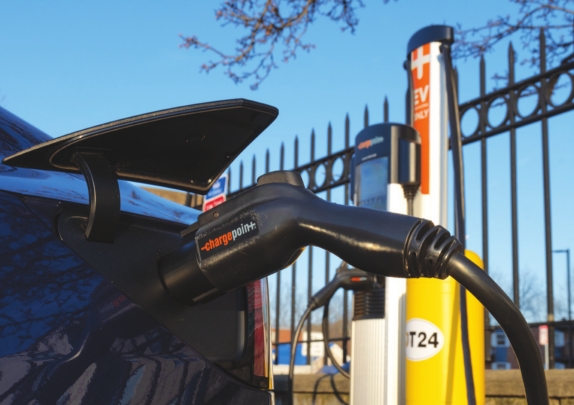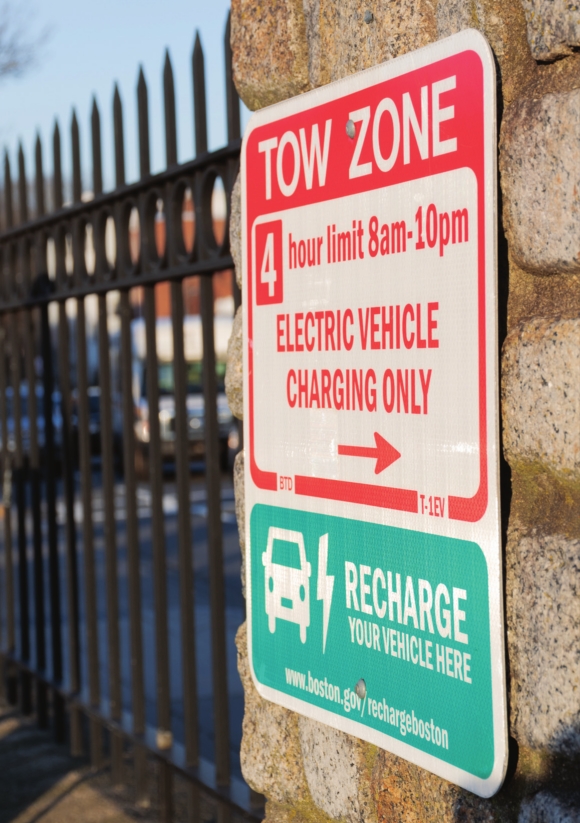
A
car charges at an electric vehicle charging station in a municipal lot
off Mattapan Square. State leaders are looking to promote electric
vehicle uptake with increased charging infrastructure and better
education about the vehicles.

A sign marks an electric
vehicle charging station at a municipal lot off Mattapan Square. State
leaders are looking to promote electric vehicle uptake with increased
charging infrastructure and better education about the vehicles.When it comes to reducing carbon emissions, electrifying the vehicles Massachusetts drivers use is a prime target for those reductions.
According to state data, in 2020, transportation accounted for about 37% of carbon emissions in the state, the most of any sector.
But even as the city and state grapple with connecting more drivers to electric vehicles, barriers still exist. High costs, especially for new vehicles, can cast electric vehicles as a luxury purchase. Limited charging infrastructure can limit access for residents, especially those without their own garage or driveway to charge in. And concerns around the range of the vehicles persists.
Top of mind for people working in the electric vehicle space in Massachusetts is connecting people in apartments and other multifamily housing without a place at home to park a car — socalled “garage orphans” — with access to charging.
“Thinking about how we can address renters and garage orphans is really a sticky barrier that we’re grappling with,” said Assistant Secretary of Energy Josh Ryor.
Increasing access to public chargers could help reduce the concerns of prospective drivers, said Justin Ren, a professor of operations and technology management at Boston University.
“If I can’t charge a car, there’s no use, right? So that’s one major hurdle. Can we do better in terms of providing public charter infrastructure?” said Ren, who is a core faculty member at the Boston University Institute for Global Sustainability.
It’s a topic that’s in focus. At the Sept. 4 meeting of the
state’s Electric Vehicle Infrastructure Coordinating Council, three
different companies, each focusing on increasing on-street charging
infrastructure, presented to the council on their work.
That
included companies that are part of an effort in the city of Boston to
increase curbside charging, part of a goal to bring charging
infrastructure within a five-minute walk of every resident in the city.
Boots-on-the-ground
efforts of installing the infrastructure, like in Boston, will largely
be up to municipalities, Ryor said, but the state is looking to provide
assistance to cities and towns in the state, including by directing
$11.25 million in funding to the Massachusetts Clean Energy Center to
create a program supporting municipal efforts to expand on-street
charging.
The request
for proposals for that Massachusetts Clean Energy Center on-street
charging program closed Sept. 4, and a representative for the center
said they hope to notify awardees by October.
But
convincing some drivers that nearby on-street charging is a viable
option would still remain a hurdle. A new study from Boston University’s
Institute for Global Sustainability and the National Renewable Energy
Laboratory that looked at barriers around electric vehicle uptake found
that just over half of individuals who
responded to their survey said they would never be willing to park
their EV away from their home to charge it. Another 21% said they’d be
willing to walk about a quarter of a mile — about the distance, on
average, covered Boston’s five-minute walk goal.
Charging infrastructure along highways, as well as the limited driving range of electric vehicles, continues to present a
concern for some drivers. The research from Boston University found that
16% of its survey respondents identified a more limited driving range
as a high barrier to electric vehicles.
Battery
electric vehicles tend be capable of driving between 100 and 400 miles
on a full charge, versus the general range of 250 to 700 miles of
combustion engine vehicles.
“If
I want to make a trip to New Hampshire, it’s going to take 300 miles,
more or less, and I just don’t want to be stranded,” said Ren, who was
not involved in the study. “Those are the kinds of concerns that are
keeping at least some people away from buying a buying electric car.”
Some
of that range anxiety is a matter of perception. Ryor pointed to
federal alternative fuels data from the Department of Energy in
comparison to the state’s Clean Energy and Climate plans and said that
he thinks the state is on track for deploying fast chargers that can get
drivers back on the road more quickly.
The
state’s Department of Transportation is looking to increase awareness
of those stations by expanding signage identifying charging stations
along state highways. At the Sept. 4 meeting of the Electric Vehicle
Infrastructure Coordinating Council, Chris Aiello, senior council for
the Department of Transportation’s Climate Initiative, said the
department had implemented a new policy around signage advertising EV
charging allowing for the signs on state highways.
“Range
anxiety remains a key barrier to EV adoption. The hope is these signs
will provide helpful information to EV drivers, but the signs will also
help to make non-EV drivers … aware of the growing network of fast
chargers along the state highways,” Aiello said at the meeting.
The
charging stations, if advertised, must be available to the public
around the clock and located within three miles of the exit. Under the
policy they will appear on roadside signs in the same way that gas
stations, food and lodging can be advertised along highways.
But
some of that charging landscape still needs to be built up. In
December, the state announced a plan to establish a network of fast
chargers in the state, looking to tap pre-qualified vendors to design,
permit and build chargers at locations along state roadways.
In
a press release at the time of the announcement, transportation
Secretary Monica Tibbits-Nutt said she thinks an expanded network will
attract more drivers to electric vehicles.
“Fast-charging stations at convenient locations along major roads will absolutely lead to
reduced air pollution, fewer gas-guzzling cars on our roads, and a
willingness by people to make smarter choices which will help combat
climate change,” she said.
The
reputation of electric vehicles of being a big-ticket purchase also can
dissuade drivers. According to Kelley Blue Book, as of January, the
average new electric car, before any state or federal rebates, cost over
$50,000, about 4% more than the overall new car market.
Some of that has changed.
Ren
pointed to five years ago, when most people would have looked only to
Tesla and its price tag that could reach up to or past $50,000 as their
reference for personal electric vehicles. For example, around the end of
April, 2021, Tesla sales made up about two-thirds of electric vehicle
scales, also according to Kelley Blue Book.
That’s
changing, though Telsa still is dominant. As of June, Tesla sales made
up just over half of all new electric vehicle sales in the United
States.
And the state is looking to make electric vehicles more affordable by expanding rebates.
It’s
MOR-EV — Massachusetts Offers Rebates for Electric Vehicles — program,
was expanded last year, with a new program for used electric vehicles
and additional incentives for lower-income residents and for swapping in
a combustion engine vehicle.
But
attracting drivers to some of those opportunities, like purchasing used
vehicles may require some work. The Boston University study found that
among all income brackets surveyed, drivers were more likely to look for
an electric vehicle new rather than used. Even among respondents making
$15,000 or less per year, if they were to consider buying a electric
vehicle, the likelihood of them buying a used electric vehicle was over
20 percentage points lower than if they were looking to buy a car
generally.
Ryor said that he hopes increased education around electric vehicle incentives might increase uptake of things like used EVs.
A
state equity report, released by the Healey-Driscoll administration at
the end of August identified improving outreach — especially in multiple
languages — and increasing education around the program as areas where
the state’s rebate program could grow stronger.
The
new Boston University research suggested that to get more drivers
behind the wheels of electric vehicles — especially in a way that
doesn’t leave communities behind — more focus needs to be given to the
human side, rather than the engineering.
“Equitable
deployment of PEVs and charging infrastructure may require a shift in
focus from a technology and innovation focus on “vehicles” to a more
holistic approach to the “people” who own and drive them,” the authors
wrote.
It’s a sentiment that Ryor said the state shares.
“We have to make sure when we’re designing these
programs and thinking through how to address these problems that we’re
meeting people where they’re at,” he said.
He
said that means engaging with the Office of Environmental Justice
within the Executive Office of Energy and Environmental Affairs, as well
as a specific push for “culturally competent” outreach tailored toward
underserved communities, communities with a high percentage of
low-income households and those with a high proportion of high-emissions
vehicles.
That
type of outreach, focused on and for specific communities, is an
important step to bring more people into the fold, Ren said.
“We
need to understand what’s the context,” he said. “We need to design the
education programming to speak to a particular culture.”
Improving
education in diverse communities was one area for growth identified by
the state equity report, which suggested that kind of education could
“meaningfully expand the conversation around who thinks they belong in
an EV.”
And a
state-funded effort through the Massachusetts Clean Energy Center would
aim to bring more educational resources about the state’s rebate program
to residents in the state, including information translated into other
languages like Spanish, Portuguese and Haitian Creole.
Ryor
said outreach to environmental justice communities needs to be specific
to each one of those communities — and that, despite all tending to
bear the brunt of environmental impacts shouldn’t be treated as monolith
— but said that those communities will be key to making a transition to
electrified travel.
“Frankly,
it’s not possible for us to meet our climate goals without making sure
that we’re including environmental justice communities and that these
folks are able to access electric vehicles and make that transition as
well,” Ryor said.